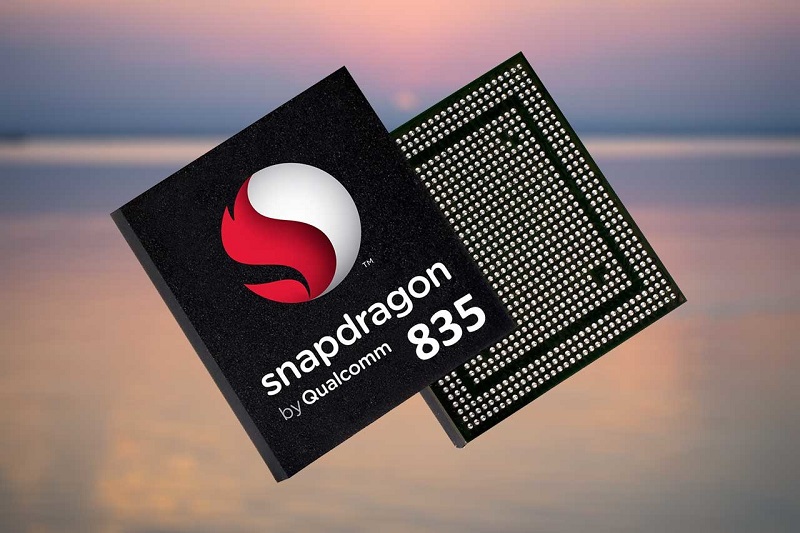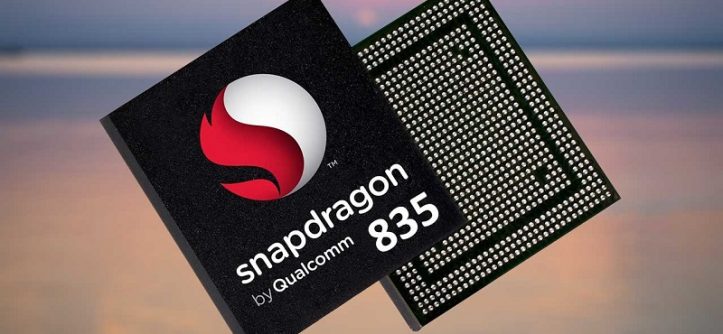The announcement of what would start in 2017 for Qualcomm came in October, confirming that the next mobile processor would be the Snapdragon 835 and not the 830 as rumored. Today the manufacturer takes advantage of CES Las Vegas 2017 to expand the information, revealing all the features in detail.
As we knew at the time, the Snapdragon 835 is the first SoC to be marketed with 10 nanometer FinFET transistors, so they want to achieve greater performance and efficiency. And now we know the details of the structure and capabilities of the new processor that takes over the Snapdragon 820 and 821.
With this reduction in size of the transistors, the Snapdragon 835 is 30% thinner than its predecessor the Snapdragon 820. Thus, to smaller size of the transistors greater speed and energy saving, hence yields are obtained 27% higher and Consumption is reduced by 40% less than processors with 14-nanometer transistors. What components and operation allow such improvement with respect to the above? We see it in detail …

The x-ray of Snapdragon 835
The idea that they have put in place in this new SoC is that each aspect to cover has its own unit, so that if we compare the structure of the 835 with the one of 821 we will see that the first one has a greater number of components than the second one. Thus, the Snapdragon 835 is structured based on the following components:
- CPUs: four Qualcomm Kryo 280 at 2.45 GHz and four at 1.9 GHz. The most powerful processors they have manufactured so far.
- Digital Signal Processor (DSP): Qualcomm Hexagon 682, which includes support for TensorFlow and Halide (for image processing).
- Graphic processing unit (GPU): The Adreno 540, a new graphics with support for OpenGL ES 3.2, complete OpenCL 2.0, Vulkan and DX12. It supports Google’s Daydream, 4K Ultra HD premium video (HDR10), 10-bit gamut screens, 3D audio and VR / AR motion tracking thanks to the six degree of freedom ( 6DoF) sensor it integrates. In addition, along with it the 835 has specific units for screen processing (DPU) and video (VPU).
- ISP Qualcomm Spectra 180: The image sensor processor, based on two 14-bit ISPs, ready for the next generation of cameras (up to 32-megapixel sensors or dual 16-megapixel cameras).
- Modem Snapdragon X16 LTE: With support for LTE category 16 (up to one gigabit per second) and category 13 (up to 150 megabits per second). It integrates MU-MIMO 2×2 802.11ac, with a reduction of 50% in size and a 60% reduction in power consumption in wifi compared to the Snapdragon 820. The WiFi is multi-gigabit 802.11ad, with 4.6 Gigabits per second of maximum speed.
- Qualcomm Aqstic Audio: Enhances positional audio.
- Qualcomm IZat Location: With support for GPS, GLONASS, BeiDou, Galileo and QZSS systems, which in combination with the wireless connection (WiFi, data or Bluetooth) provides constant information of location and context.
- Qualcomm Haven: A platform for security, with dedicated hardware and software.
Kryo cores have already been used in Snapdragon 820 and 821 among others and are semi-customized . In this case there are eight, four most powerful performance-focused ones that can reach 2.45 GHz (for tasks like VR, web browsing, application loading, etc.) and minors (up to 1.8 GHz ) Focused on efficiency. Qualcomm also has the Symphony System Management SDK for developers to control how they want to use each unit (CPUs, DSPs or GPUs).
A future of virtual reality and powerful cameras, and five pillars of action
Beyond the basic objectives to be covered, such as power, efficiency or adjusting consumption, the Snapdragon 835 has been devised and manufactured with a view to a market in which more and more often certain uses or development paths are repeated. One of them is artificial intelligence, for which machine learning is key, and this is related to the five pillars on which they have focused for the processor.
- Battery: Because the transistors are smaller, the Snapdragon 835 manages to consume 25% less energy compared to the more powerful processors of previous generations , which results in a longer battery life (and also with the possibilities Of mounting it in finer boxes). In addition, it incorporates as we already saw Quick Charge 4.0 , which allows a 20% faster load and 30% more efficient than its previous version (Quick Charge 3.0).
- Capture: The cameras of the smartphones are becoming more powerful and also is establishing the tendency to integrate a double lens.
- Connectivity: Facing a future that integrates and expands the 5G and the rest of technologies to come in this aspect, the LTE X16 modem that integrates the Snapdragon 835 makes it the first commercial processor that can provide Gigabit connectivity.
- Security: Along with the sensitivity and efficiency of sensors and proprietary software, the role of the processor is key in the level of security. Here the protagonist will be the own Haven platform, which provides support for biometrics (fingerprint, eye and face), as well as user authentication and security functions such as mobile payment and user data.
- Immersion: This word is becoming more common in technology with the rise of immersive experiences like virtual reality (VR), which requires power as well as image and sound quality. The Snapdragon 835 promises a 25% increase in performance when rendering 3D graphics and 60 times more colors with the new GPU.
To cover these five fronts in the design and construction of the Snapdragon 835, the approach was the one we mentioned at the beginning of having a unit dedicated to each main task. Hence, we talk about a heterogeneous computation, which we will see in detailing some of these pillars below.
Finer batteries, processor with less consumption
The autonomy of smartphones is one of the technologies with a more limited development if we compare their evolution with that of others such as cameras or screens, since lithium ion batteries have long been standardized and to date are the ones that are Are using, trying to have the maximum milliamps / hour in each case. But beyond the capacity of the same and what activity the user does, the processor also has an important role in consumption.
What Qualcomm says is that Snapdragon 835 is somewhat more safer than its predecessor in 820; Specifically give 2.5 hours more autonomy at the end of the day (on average, always depend on battery and usage). According to internal tests, this is what the Snapdragon 835 promises in terms of battery life according to uses (compared to previous processors):
- Conversation: one more day.
- Playing music: five more days.
- Video playback in 4K: eleven hours more.
- Streaming video in 4K: seven hours more.
- Capture video in 4K: three hours more.
- VR: two more hours.
With a smaller size of the transistors is achieved, on the one hand, greater speed and autonomy, and on the other, gain space
This greater autonomy is achieved in part thanks to the reduction of the size of the transistors. As we mentioned in its introduction and introduction, the 835 sets finFET transistors of 10 nanometers, or what is the same, a smaller size of these, which gives on one side more autonomy and speed, and on the other that occupies more Space (something that seems key in a market in which it is still tending to thin the smartphones as much as possible).
Another factor that helps to obtain a better autonomy is the specification of components. Hence, Qualcomm has been oriented towards the provision of sub-units for each function, for example by diversifying the DSPs (a smaller one that works constantly and a bigger one for tasks that require it) or thanks to the activity of the All-Ways Aware Hub.
For its part, the Hexagon processor allows you to save battery in tasks like the VR. According to Travis Lanier, senior director and product manager at Qualcomm, the head movement tracking is low-power and the 6DOF sub-system (six degrees of freedom) Visual Inertial Odometry (VIO) is, according to its tests, four Times more efficient than a CPU.
In addition, as we mentioned before, the Snapdragon 835 integrates the new Quick Charge 4.0 that we talked about in its presentation last November. The data that we have at the moment are the tests that were made with a battery of 2750 milliamps, obtaining five hours of battery with five minutes of load.
You may also like to read another article on improtecinc: Snapdragon 653, 626 and 427, debuts Qualcomm dual camera support for the mid-range
Preparing for powerful and double cameras
Tim Leland, vice president of product for Qualcomm, was in charge of talking about the part of Snapdragon 835 related to photography. An area in which smartphone manufacturers have put a lot of dedication and effort to create lenses that manage to highlight each time only a few millimeters thick, and that in the last year have drawn that trend to the double lens we mentioned.
Here again the components specification is discussed and heterogeneous computing is discussed, focusing on the ISP Qualcomm Spectra 180, which has two dedicated units : one to wide-angle lenses and the other to telephoto lenses. In this way, they try to avoid avoiding the vibrations (blurred photos).
And in conjunction with this heterogeneous approach, what Qualcomm has been inspired to improve performance in photography (and also in terms of VR, we will see later) is in the anatomy of the eye. With a small reminder of biology classes, they talked about the different types of retinal cells, cones and rods, which are responsible for color vision and black and white respectively.
And this helped them to talk about the pair of dedicated sensors, one in color and the other in black and white, which integrates the ISP and Clear Sight, the algorithm that works with them. In this way, we aim to achieve greater clarity, improve the dynamic range and eliminate noise in low light.
What makes clear is that the Snapdragon 835 is prepared to give support to the double camera no matter what the application of it, given that, as reviewed here, manufacturers prefer a combination or other lens according to what they want to achieve. They have also added support for dual photodiode auto focus (2PD), that is, the use of two photodiodes per pixel (one dedicated to capture and the other to detect faces) which are considered one of the future trends in mobile photography.
Other improvements include the autofocus (faster and better in low light), where the DSP Hexagon is involved, and the new EIS 3.0, an electronic stabilization for video. In addition, the 835 incorporates a hybrid framework for the autofocus that allows working in low light to be faster and more efficient, using 2PD, autofocus phase detection, laser focus or other camera features as appropriate.
Security: From the app to the processor and vice versa
From the democratization of the fingerprint sensor beyond the high end, smartphones are using different sensors and systems beyond the codes and standards for terminal security. This is not new, but there is a tendency to innovate in this sense with iris or retina scans like Windows Hello.
That is why in Qualcomm have also been dedicated to improving the part of security that depends on processors to meet these “new” requirements. In this sense, Sy Choudhury, senior director and product manager of Qualcomm, emphasized that he or she is important in the recognition of the footprint beyond the sensor are these three points:
- The physical bus that controls the recognition (which is in the processor).
- The driver that is running.
- The template that represents the finger and is stored.
Focusing on facial recognition, he also clarified that the iris is more specific than a fingerprint and hence they have focused on supporting this recognition. Here the units that work are the GPU and Haven, being the hardware component of the latter one of the sub-units dedicated to security.
The Snapdragon 835 comes with a Secure camera foundation , dedicated to unlocking with face, retina and iris, and the Secure voice chanell, a secondary authentication actor added to the unlocking by image (the previous ones or the fingerprint ). What they have looked for is multifactor authentication, in which hardware, location and software intervene in security, focusing on giving adequate support to the breakthroughs that they consider to be safer (facials).
Virtual reality, one of the central points of development
One of the most mentioned applications in its presentation was virtual reality, being one of the current trends and, in addition, a very demanding task at the hardware level. Thus, part of the development of the Snapdragon 835 has focused on this task is performed efficiently and also for greater immersion.
In order to do so, they have been rendered faster, according to their tests, 25% more than the previous one, greatly improving the photon latency (rendering is direct, it does not have to go from one unit to another, and that is faster). The 835 also releases Foveate Rendering, a name that comes from the fovea, the part of the eye that defines the focus.
But in addition to the image, for the investment is important the quality of the audio. Here again they emphasize their approach of working with specific units and the heterogeneous computation is also used for the improvement of audio, also premiering the 3D audio SDK and the crystal audio codec.
The new processor also supports 4K Ultra HD Premium (HDR10) video. And beyond the Snapdragon 835, Qualcomm is working on the design of several virtual reality helmets, focusing among other aspects on the RV without cables.
A small processor with big aspirations
Following with figures and percentages, with this processor Qualcomm has managed to reduce consumption by 50% compared to Snapdragon 801. From today we know in detail what makes possible both the lowest consumption and the highest efficiency according to the manufacturer, but what we still do not know is what phones will be the first to assemble it.
A size reduction that will not only impact on speed and battery savings, but will also leave more space for the design and construction of mobile phones. To this alluded Cristiano Amon, Executive Vice-President of Qualcomm, emphasizing in relation that the Snapdragon 835 helps to have a better autonomy.
In addition, with the trend towards hardware and software development for virtual and augmented reality, and with increasing cloud services, the Snapdragon 835 is designed to support smartphones, tablets, IP cameras and all the new generation devices that fit into these applications. Thus, the processor will have support for Android and Windows 10 including Win32 apps.
More on: http://gamesplanet.org/
Tags: Snapdragon 835




Leave a Reply